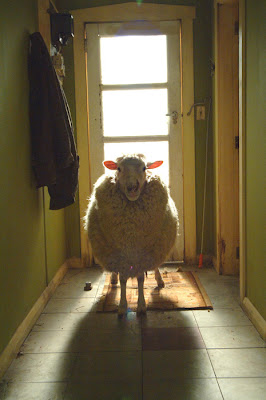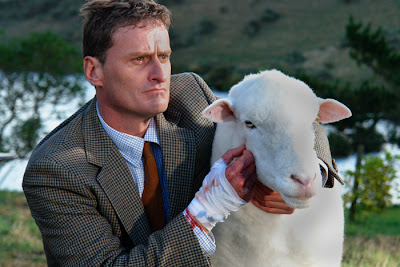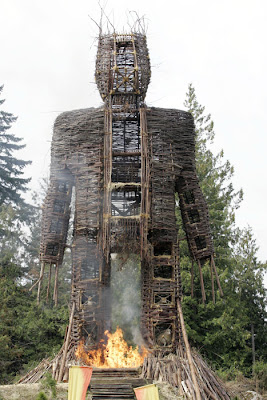While the rest of the class was learning about how electricity travels from one spot to the next or some such thing, Trev and I were teaching ourselves how to make mini-skateboards and redefining the safety pin into some sort of fashion statement. There was one thing that I created during this period that I never did anything with, but has stuck with me trough the years. I wonder if Trev would even remember this concept I developed.
My obsession with movies was well established by this point in time, however undeveloped. Mine and Trev’s mutual obsession with horror fueled much of our musings. From these influences, I developed a character that would star in a series of films. Trev and I spent much of our time in that science class coming up with titles for this fictional film franchise.
 The character was not a person, although it had a personality. It was in fact a lamb. The deadliest lamb the world had ever seen. So deadly, he was known as Killer Lamb. The franchise would start with the film simply titled “Killer Lamb”. Then, in an unprecedented move by the character’s creators, the second film would be titled “The Death of Killer Lamb”. But the series would be revitalized with its third installment “Killer Lamb Lives!”. All subsequent titles of the series would be takes on already existing film titles, such as “The Hunt for Killer Lamb”, “Killer in Pink”, “The Killer Lamb Club”, “Some Kind of Killer Lamb”, “Raiders of the Killer Lamb”, “Killer Lamb and the Temple of Doom”, “Night of the Killer Lamb”, “Lamb”, “Killer Lamb 2: Kill Harder”, “Killer Lamb: First Blood, Part II”, “Killer Lamb II: The Wrath of Killer Lamb”, (Yes, there were several second episodes to the series.) “Killer Lamb III: The Search for Killer Lamb”…. And I’m sure you more than get the point, but I was having fun.
The character was not a person, although it had a personality. It was in fact a lamb. The deadliest lamb the world had ever seen. So deadly, he was known as Killer Lamb. The franchise would start with the film simply titled “Killer Lamb”. Then, in an unprecedented move by the character’s creators, the second film would be titled “The Death of Killer Lamb”. But the series would be revitalized with its third installment “Killer Lamb Lives!”. All subsequent titles of the series would be takes on already existing film titles, such as “The Hunt for Killer Lamb”, “Killer in Pink”, “The Killer Lamb Club”, “Some Kind of Killer Lamb”, “Raiders of the Killer Lamb”, “Killer Lamb and the Temple of Doom”, “Night of the Killer Lamb”, “Lamb”, “Killer Lamb 2: Kill Harder”, “Killer Lamb: First Blood, Part II”, “Killer Lamb II: The Wrath of Killer Lamb”, (Yes, there were several second episodes to the series.) “Killer Lamb III: The Search for Killer Lamb”…. And I’m sure you more than get the point, but I was having fun.I even continued my practice of Killer-izing movie titles well into adulthood and came up with one of my favorites in college, “The Violence of the Lamb”. What a surprise it was for me then to see the trailer for the New Zealand horror/comedy “Black Sheep” with the tag line, “Get ready for the violence of the lambs.” In watching this quirky comedy about genetically mutated sheep turned into crazed killing machines I did not feel my idea of a lamb on a killing spree was stolen; but rather that it had finally been realized. And not only do the lambs in this movie kill; their victims then become were-sheep. Sweet!!!
 This film brought me so much pleasure. Its hero is tortured with a phobia of sheep, due to a traumatizing childhood incident. It has environmentalists who are numb to the realities of the world through their own fanatic idealism. There is a scene right out of Woody Allen’s “Everything You Always Wanted to Know About Sex * But Were Afraid to Ask” inspired by Gene Wilder’s frisky livestock vet. To quote Jonathan King’s wonderful “Black Sheep” screenplay, “That brings a whole new definition to ‘animal husbandry.’” The scene where a sheep drives a truck off a cliff brings back memories of “Toonces the Driving Cat” from “Saturday Night Live”. And who would’ve thought that mint jelly is to zombie sheep as holy water is to demons.
This film brought me so much pleasure. Its hero is tortured with a phobia of sheep, due to a traumatizing childhood incident. It has environmentalists who are numb to the realities of the world through their own fanatic idealism. There is a scene right out of Woody Allen’s “Everything You Always Wanted to Know About Sex * But Were Afraid to Ask” inspired by Gene Wilder’s frisky livestock vet. To quote Jonathan King’s wonderful “Black Sheep” screenplay, “That brings a whole new definition to ‘animal husbandry.’” The scene where a sheep drives a truck off a cliff brings back memories of “Toonces the Driving Cat” from “Saturday Night Live”. And who would’ve thought that mint jelly is to zombie sheep as holy water is to demons.While it is really a silly premise that only gets past the half hour point by remaining resolutely clever and utilizing the charm of its New Zealand cast, there is little to take fault with in this set up. You don’t have to worry about taking it seriously, which frees your mind to catch all the references to horror clichés and even specific horror movies. The sheep sticking its head through the locked bedroom door―“The Shining”. The flock of sheep feasting on the victims in the field―“Night of the Living Dead”. The transformation scene―“An American Werewolf in London”. “Black Sheep” may not be high art, but it is a whole lot of fun.
***
 Each year there is a movie or two that is a quirky, yet understated comedy along with being good horror. Trev helped guide me to another of these films this year in the independent release “Dead End”, not to be confused with the new direct-to-DVD release “Wrong Turn 2: Dead End”. No, “Dead End" was quietly released to probably 2 or 3 U.S. theaters in 2004 after a world tour of theatrical releases and film festivals. It effectively fell through the cracks.
Each year there is a movie or two that is a quirky, yet understated comedy along with being good horror. Trev helped guide me to another of these films this year in the independent release “Dead End”, not to be confused with the new direct-to-DVD release “Wrong Turn 2: Dead End”. No, “Dead End" was quietly released to probably 2 or 3 U.S. theaters in 2004 after a world tour of theatrical releases and film festivals. It effectively fell through the cracks.“Dead End” involves a family driving to Christmas dinner through a winding dark back road. The quirky actor from “Twin Peaks”, Ray Wise plays the family patriarch, which should tell you a little about the film right there. After a Griswold family vacation moment of falling asleep at the wheel, the dad sees something in the woods and stops the car, never a good thing to do in a horror movie.
While the plot from this point is something predictable for the horror palate, the execution in this ultra-low budget picture is something of an exquisite rarity. Writer-directors Jean-Baptiste Andrea and Fabrice Canepa do a wonderful job of capturing the family dynamic of being trapped together on a road trip to a holiday outing no one really wants to attend. Their acute observation of familial behavior adds authenticity and humor to the material. I loved the way the brother and sister bickered, but really seemed to love each other deep down; and the mother’s (another brilliant quirky actor, Lin Shaye) and father’s relationship has that lived in and sick of each other but used to it feel that long married couples have. And what a splendid joke that the boy friend’s death is handled as if it were an acceptable loss for the trip.
***
 As quirky independent horror films go Anthony Shaffer’s “The Wicker Man” (1973) stands atop the cult heap. I was lucky enough to screen that film during last year’s Horrorfest. I was not so lucky to screen the Nicolas Cage 2006 remake this year. I don’t know what is up with Cage lately. He seems to be pursuing passion projects based on material of which he has personally been a fan, but the results of this film and this past Spring’s “Ghost Rider” have only inspired passionate distaste.
As quirky independent horror films go Anthony Shaffer’s “The Wicker Man” (1973) stands atop the cult heap. I was lucky enough to screen that film during last year’s Horrorfest. I was not so lucky to screen the Nicolas Cage 2006 remake this year. I don’t know what is up with Cage lately. He seems to be pursuing passion projects based on material of which he has personally been a fan, but the results of this film and this past Spring’s “Ghost Rider” have only inspired passionate distaste.At least David S. Goyer had abandoned his writing credit on “Ghost Rider” before it was finally filmed, but Neil LaBute’s adaptation of “The Wicker Man” is inexplicable. LaBute has been responsible for some of the more scathing explorations of gender relations in such films as “In the Company of Men”, “Your Friends & Neighbors”, and “The Shape of Things”. What he does by turning “The Wicker Man” into a feminist tirade is inexcusable.
LaBute has been criticized before for his treatment of women on the screen, but most of those critiques were overlooking the nasty statements he was making about men. Here LaBute and Cage have completely flipped the traditional roles of men and women in horror. The women are the authorities in “The Wicker Man” and hold all the cards over Cage’s powerless victimized police officer. This entailed changing some crucial details of the original screenplay in which the whole town visited by the police officer, women and men, were duplicitous in his fate.
I suppose this can been seen as some extreme form of women’s liberation ― Look, we can be monsters too! ― but isn’t this missing the point of equal rights? Am I wrong to think the desire for equality is supposed to be striving toward some sort of peace? Perhaps I am, but more important is the fact that this movie just plain stinks.
The original “Wicker Man” is a mysterious parable about faith and its relationship to society. There are scenes of disturbing imagery and even more disturbing ideology. This update lacks any sort of real mystery in the way it forces relationships on the characters that are unnecessary, such as Cage’s connection to the girl whose disappearance he has come to investigate on a secluded island. LaBute makes the cult nature of the people living on this island apparent from the beginning, whereas the original made this island community look like a normal town for a while, if just a little bit eccentric.
What ever the differences, Cage’s and LaBute’s vision of “The Wicker Man” is not scary, creepy or even remotely interesting. Rent the original instead.
This is one of those scenes created for the new version that is absolutely pointless and makes little sense in the context of the resolution of the film.





No comments:
Post a Comment